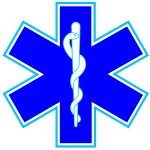Initial Trauma Assessment and Care
From Protocopedia
Section 2 - PRIMARY CARE
2.02 INITIAL TRAUMA ASSESSMENT AND CARE
GENERAL:
- Assess and secure scene safety.
- Use universal blood and body substance isolation precautions on all patients.
- Assess for potential injuries based on mechanism of energy transfer.
- Identify and treat immediate life threats per specific PRACTICE PARAMETERS.
- Initiate trauma alert when appropriate from scene.
- Perform blood draw of all tubes on a trauma alert patient. The crew shall hold onto the tubes at the hospital until a staff member is ready to label the blood tubes. Document that blood was drawn.
- Attempt to limit on-scene time to no longer than 10 minutes.
- Apply initial medical care.
INITIAL ASSESSMENT:
GENERAL IMPRESSION
Level of Consciousness
| A | Alert |
| V | Respond to Verbal Stimuli |
| P | Respond to Painful Stimuli |
| U | Unresponsive |
ORIENTATION x 4/4:
| 4/4 | Person, place, time, incident. |
| 3/4 | One faculty absents |
| 2/4 | Two faculties absent. |
| 1/4 | Three faculties absent. |
DISTAL:
| P | Pulse |
| M | Motor |
| S | Sensory |
Altered Mental Status (AMS) is defined as an alteration in either the patient’s LOC or Orientation
- AIRWAY / C-SPINE: Manual C-spine immobilization may be indicated in patients with injury indicative of spinal loading or stretching, significant injury above clavicles, head injury resulting in AMS, or mechanism of injury that suggests sudden or violent movement of the spine. Refer to SELECTIVE SPINAL IMMOBILIZATION PRACTICE PARAMETER (6.03). Position airway and suction as needed. If intubation required, utilize in-line or nasotracheal technique unless contraindicated. If unable to secure airway by other means and airway not patent, perform Cricothyrotomy.
- BREATHING: Check breath sounds, assess for JVD and tracheal deviation, use of accessory muscles of respiration. Assess for tension pneumothorax. If ineffective breathing pattern / impaired gas exchange, deliver OXYGEN via NRB mask or assist with BVM.
- CIRCULATION:Evaluate peripheral pulses for presence, quality and equality. CPR as indicated. Treat severe external hemorrhage with direct pressure. If patient has AMS or diabetes, assess blood glucose level, if < 100 mg / dl refer to AMS PRACTICE PARAMETER (5.03).
- ADEQUATE PERFUSION: large bore IV @ KVO.
- INADEQUATE PERFUSION: Institute SHOCK PARAMETER (5.13) therapies enroute unless delayed by extrication
THE UNSTABLE PATIENT MUST BE TRANSPORTED IMMEDIATELY.
